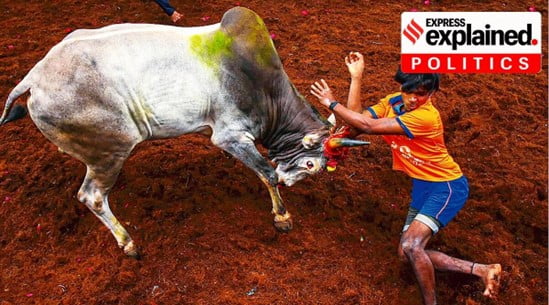History and Art and Culture
In News: the Supreme Court observed while hearing the Jallikattu case that, prevention of cruelty is not an “absolute idea”. The Constitution commands us to be compassionate to all living creatures, but it should have a balance.
- The Bench also referred to the killing of stray dogs, saying it extinguished the life of an animal.
About Jallikattu:
- It is an ancient ‘sport’ or bull taming event typically practiced in Tamil Nadu as a part of Pongal celebrations on Mattu Pongal day, third day of the four-day Pongal festival.
- Jalli refers to gold or silver coins and Kattu means ‘tied’.
- Therefore, combined it refers to coins being tied to the bulls’ horns, which is considered the prize for whoever tames the bull.
- The bull that wins is used to service numerous cows preserving the native breed.
- It is believed to have been practised some 2500 years ago.
- It is controversial because the sport often results in major injuries and even deaths.

About the case:
- In 2018, the apex court had referred to a Constitution Bench the question whether the people of Tamil Nadu could preserve jallikattu as their cultural heritage under Article 29 (1) of the Constitution and demand for its protection.
- The People for Ethical Treatment of Animals (PETA) filed a petition to strike down the Prevention of Cruelty to Animals (Tamil Nadu Amendment) Act of 2017 and Prevention of Cruelty to Animals (Conduct of Jallikattu) Rules of 2017.
- In 2021, the Environment Ministry declared that the sport could carry on irrespective of the imposed ban.
- A research conducted by PETA’s investigators found that the bulls were being disoriented, deliberately. The bulls’ tails were allegedly bitten and twisted; stabbed, punched, and dragged on the ground.
Source The Hindu
Previous Year Question
Q.1) With reference to India’s culture and tradition, what is `Kalaripayattu’? (2014)
- It is an ancient Bhakti cult of Shaivism still prevalent in some parts of South India
- It is an ancient style bronze and brasswork still found in southern part of Coromandel area
- It is an ancient form of dance-drama and a living tradition in the northern part of Malabar
- It is an ancient martial art and a living tradition in some parts of South India












